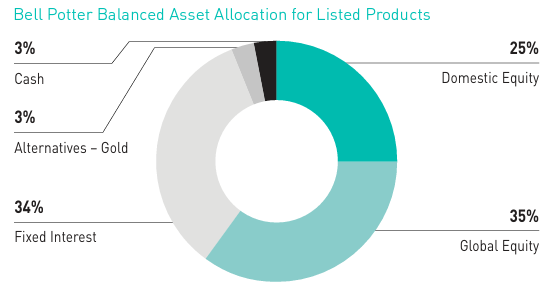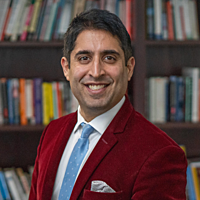A stockbroker’s guide to building a diversified ETF portfolio (plus their 13 top picks)
Last month, I published a simple guide on how to build a smarter ETF portfolio, encouraging investors to think about the goals they’re trying to solve with their investments and to create their own “approved list” of funds - much like an adviser would.
Admittedly, that guide was designed as a starting point, focused mainly on equity and fixed income investors who prefer to keep things simple.
Shortly after, Bell Potter released a far more sophisticated take on the same idea: how to execute a strategic asset allocation (SAA) and build a multi-asset portfolio using ETFs.
Written by Rob Crookston, Head of Investment Strategy, and Kion Sapountzis, Investment Strategy Analyst, the report explores how to blend active and passive exposures, where tactical tilts fit in, and which products the team considers suitable across equities, fixed income, and alternatives.
Crookston and Sapountzis previously argued that investors should pay more attention to their SAA - the architecture of a portfolio - rather than obsessing over individual security selection. This latest report shows how to put those foundations into practice using ETFs.

Why Bell is backing ETFs
Let’s start with the basics: why is Bell such a fan of ETFs? The answer comes down to efficiency, transparency, and cost - plus the fact they’ve become an established part of the investment ecosystem. ETFs now account for more than 10% of ASX trading volume.
It’s the transparency that Bell particularly values when constructing multi-asset portfolios:
“ETF issuers are required to publish their portfolio holdings (often daily) to ensure investors understand their underlying exposures. This allows asset allocators to confidently allocate to various strategies and allows investors to ensure alignment with their investment goals,” they said.
What they look for in an ETF
Many investors take a lowest-common-denominator approach and simply pick the cheapest fund. Bell’s process goes further.
While liquidity, issuer reputation, product longevity and tracking error all matter, index methodology and market efficiency drive the active versus passive decision.
“We see a trend where, in highly efficient markets, passive ETFs are an effective tool for capturing beta, while in less efficient or smaller markets, active managers have greater opportunity to exploit mispricings and generate alpha,” wrote Crookston and Sapountzis.
Active managers become particularly important in concentrated markets. As technology now accounts for around 35% of the S&P 500, and banks and materials make up more than 50% of the ASX 200, the ability to move capital away from crowded trades and towards underappreciated areas adds diversification and defensiveness.
Bell currently splits its model portfolio roughly 50/50 between active and passive, preferring to skip “smart beta” ETFs with quantitative screens and instead focus on either pure index trackers or genuinely active managers, whose fees have been declining over time.
How the BALANCED portfolio is positioned
Bell’s SAA, shown below, is anchored to three key principles:
- Diversification across asset classes – blending equities, fixed income, global markets, and alternatives to reduce reliance on any single driver of returns.
- Optimising risk-adjusted returns – balancing upside potential with downside protection based on long-term market assumptions.
- Alignment with long-term objectives – anchoring allocations to structural rather than cyclical views.

To complement this, Bell integrates tactical asset allocation (TAA) - measured short - to medium-term tilts based on macro conditions and valuation signals.
“Our tactical ideas are meant to be temporary. By being conscious of our position relative to our SAA over time, we avoid the risk that the portfolio becomes permanently skewed towards a single theme or risk factor,” they said.
Australian equities - 25% of SAA
Despite high valuations, Bell remains constructive on Australian equities.
“An allocation to domestic equities makes sense for most investors, given the benefit of franking credits, acting as a significant enhancer to after-tax returns,” they said.
With the domestic equity bucket, Bell Potter allocates 80% to the broad market via Vanguard Australian Shares Index ETF (ASX: VAS) and the balance to small caps via Vanguard Australian Small Companies Index ETF (ASX: VSO).
The small-cap sleeve helps offset index concentration and provides exposure to higher-growth sectors like healthcare and technology.
Global equities — 35% of SAA
One of the biggest shifts among allocators in recent years has been the growing preference for offshore markets. Historically, Bell Potter notes that a 30–40% allocation to global equities has improved risk-adjusted returns and reduced overall portfolio volatility.
"By avoiding global equities entirely, investors miss out on portfolio diversification and access to structural growth trends which remain agnostic to the domestic market," wrote Crookston and Sapountzis.
The firm is currently underweight the U.S., leaning towards quality and hedging around 40% of the currency exposure. Their current preferred mix in the international equity bucket includes:
- 15% to Plato Global Alpha Fund Complex ETF (ASX: PGA1)
- 15% to Vanguard MSCI International Shares ETF (ASX: VGS)
- 12.5% to L1 Capital International Active ETF (ASX: L1IF)
- 10% to Lazard Global Listed Infrastructure Active ETF (ASX: GIFL)
- 7.5% to GCQ Global Equities Complex ETF (ASX: GCQF)
- The remaining balance in Vanguard MSCI International Shares (Hedged) ETF (VASX: GAD)
Fixed interest and cash — 37% of SAA
After years of low yields, rising global interest rates have reset the return landscape. Bell sees an attractive entry point for bond investors and opts for a fully active approach.
“Active managers utilise market volatility to position their portfolios, capturing returns through yield curve positioning, income, and managing credit spreads and duration,” they said.
Their preferred lineup:
- 40% to Betashares Western Asset Australian Bond Active ETF (ASX: BNDS)
- 30% to Perpetual Diversified Income Active ETF (ASX: DIFF)
- 20% to Daintree Core Income Active ETF (ASX: DCOR)
- 10% to Schroders High Yield Active ETF (ASX: HIGH)
Alternatives — 3% of SAA
Finally, alternatives. For now, Bell keeps it simple and liquid.
Their preferred exposure is Perth Mint Gold (ASX: PMGOLD), one of the oldest and largest gold ETFs on the ASX, with over $16 billion in FUM and a 0.15% management fee.
PMGOLD offers the “best of both worlds” - physical gold backing guaranteed by the Government of Western Australia and the convenience of on-exchange trading.
Concluding remarks
Remember, your SAA blueprint is like the foundation of a solid home. A strong design (your asset allocation) and quality materials (the ETFs you choose) do most of the heavy lifting for long-term wealth creation.
Bell Potter’s research offers one example of how to put an SAA into practice. If you’ve been investing without a clear plan - buying a bit of everything and hoping for the best - this framework hopefully shows how to bring structure and discipline to your portfolio.
2 topics

